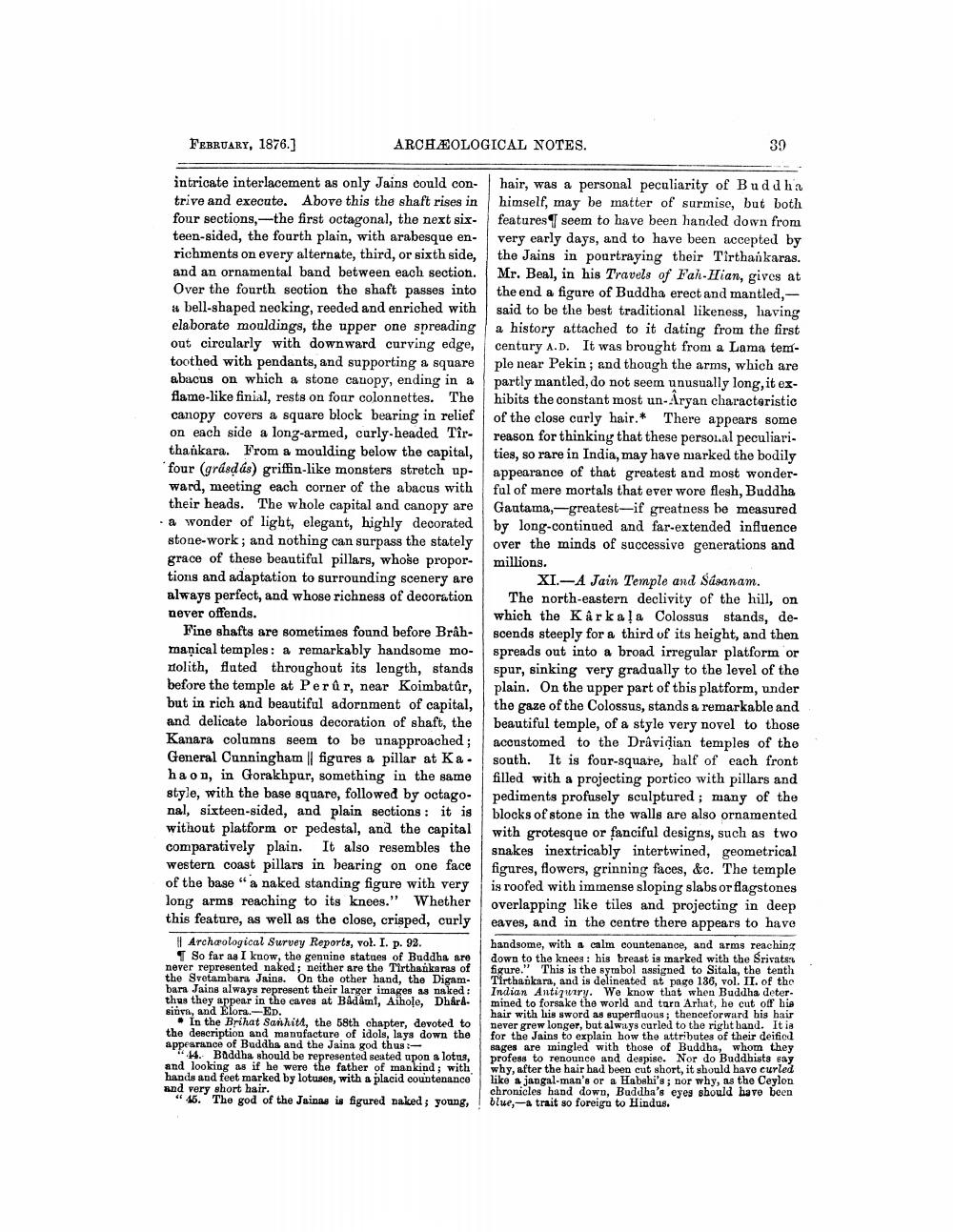________________
FEBRUARY, 1876.]
ARCHÆOLOGICAL NOTES.
39
intricate interlacement as only Jains could con- hair, was a personal peculiarity of Buddha trive and execute. Above this the shaft rises in himself, may be matter of surmise, but both four sections, the first octagonal, the next six features seem to have been handed down from teen-sided, the fourth plain, with arabesque en- very early days, and to have been accepted by richments on every alternate, third, or sixth side, the Jains in pourtraying their Tirthankaras. and an ornamental band between each section. Mr. Beal, in his Travels of Fah-Jian, gives at Over the fourth section the shaft passes into the end a figure of Buddha erect and mantled, - #bell-shaped necking, reeded and enriched with said to be the best traditional likeness, having elaborate mouldings, the upper one spreading a history attached to it dating from the first out circularly with downward curving edge, century A.D. It was brought from a Lama temtoothed with pendants, and supporting a square ple near Pekin; and though the arms, which are abacus on which a stone canopy, ending in a partly mantled, do not seem unusually long, it exflame-like finial, rests on four colonnettes. The hibits the constant most un-Aryan characteristic canopy covers a square block bearing in relief of the close curly hair.* There appears some on each side a long-armed, curly-headed Tîr- reason for thinking that these personal peculiari. thankara. From a moulding below the capital, ties, so rare in India, may have marked the bodily 'four (grásd as) griffin-like monsters stretch up- appearance of that greatest and most wonderward, meeting each corner of the abacus with ful of mere mortals that ever wore flesh, Buddha their heads. The whole capital and canopy are Gautama, -greatest-if greatness he measured a wonder of light, elegant, highly decorated by long-continued and far-extended influence stone-work; and nothing can surpass the stately over the minds of saccessive generations and grace of these beautiful pillars, whose propor- millions. tions and adaptation to surrounding scenery are XI.- A Jain Temple and Susanam. always perfect, and whose richness of decoration The north-eastern declivity of the hill, on never offends.
which the Karkala Colossus stands, deFine shafts are sometimes found before Brâh- scends steeply for a third of its height, and then maņical temples: a remarkably handsome mo- spreads out into a broad irregular platform or nolith, fluted throughout its length, stands spur, sinking very gradually to the level of the before the temple at Perûr, near Koimbatur, plain. On the upper part of this platform, under but in rich and beautiful adornment of capital, the gaze of the Colossus, stands a remarkable and and delicate laborious decoration of shaft, the beautiful temple, of a style very novel to those Kanara columns seem to be unapproached; accustomed to the Dravidian temples of the General Cunningham || figures a pillar at Ka south. It is four-square, half of each front ha on, in Gorakhpur, something in the same filled with a projecting portico with pillars and style, with the base square, followed by octago- pediments profusely sculptured ; many of the nal, sixteen-sided, and plain sections: it is blocks of stone in the walls are also ornamented without platform or pedestal, and the capital with grotesque or fanciful designs, such as two comparatively plain. It also resembles the
snakes inextricably intertwined, geometrical western coast pillars in bearing on one face figures, flowers, grinning faces, &c. The temple of the base "a naked standing figure with very is roofed with immense sloping slabs or flagstones long arms reaching to its knees." Whether overlapping like tiles and projecting in deep this feature, as well as the close, crisped, curly eaves, and in the centre there appears to have Archaological Survey Reports, vol. I. p. 92.
handsome, with a calm countenance, and arms reaching So far as I know, the genuine statues of Buddha are down to the knees: his breast is marked with the Srivats never represented naked; neither are the Tirthankaras of figure." This is the symbol assigned to Sitala, the tenth the Svetambara Jaina. On the other hand, the Digam- Tirthankara, and is delineated at page 186, vol. II. of the bara Jains always represent their larger images as neked: Indian Antiquiry. We know that when Buddha deterthes they appear in the caves at Badamt, Aihole, Dhård. mined to forsake the world and tarn Arhat, he cut off bis siive, and Elona.-ED.
hair with his sword as superfluous; thenceforward his hair • In the Brihat Sanhitt, the 58th chapter, devoted to never grew longer, but always curled to the right hand. It ia the description and manufacture of idols, lays down the for the Jains to explain how the attributes of their deified appearance of Buddha and the Jaina god thus:--
Bages are mingled with those of Buddha, whom they 4. Boddha should be represented seated upon a lotus, profess to renounce and despise. Nor do Buddhists say and looking as if he were the father of mankind; with why, after the hair had been cut short, it should have curled hands and feet marked by lotuses, with a placid countenance like a jangal-man's or a Habshi's; nor why, as the Ceylon and very short hair.
chronicles hand down, Buddha's eyes should have been "45. The god of the Jains is figured naked; young, ! blue,-a trait so foreign to Hindus.
proferere mingle plain boxeur led to the forward this the




